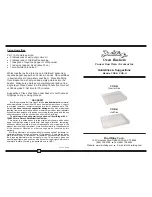
Place your food inside the zip top bag but do not seal the bag.
Slowly immerse the zip top bag with food (bottom first) into the
preheated water bath. As the bag is lowered into the water, it will
push the air out of the bag.
Continue immersing the bag until the water just about reaches the
bottom of the zipper.
Hold this position and seal the top of the bag, forcing out any
remaining air.
Using a clip (such as a binder clip, clothespin, etc.), affix the top of
the zip top bag to the cooking vessel.
You are now ready to begin the cooking process.
1
2
3
4
5
6
Water Displacement Method
Besides cooking food in vacuum-sealed bags, zip top freezer bags that
are BPA-free can also be utilized. Use the “water displacement method”
for zip top freezer bags as outlined below:
Use quality, name-brand zip top freezer bags for cooking. At cooking
temperatures above 160°F, even quality bags are susceptible to breaking
open. For higher temperature cooking, place food in heavy duty sous
vide bags or a double layer of zip top bags.
Most foods (because of their weight) will fully immerse themselves
under water in the cooking vessel. However, lighter foods such as
vegetables may not displace enough water to sink. If this happens,
simply place a piece of non-reactive metal cutlery, such as a spoon, in
the bag with the food.
Depending on the temperature and length of cooking time water can
evaporate quickly during the cooking process and potentially cause it
to fall below the MIN level marking. An easy way to delay this process
is to cover the pot with stretch wrap being careful not to cover the
actual immersion circulator.
Place a trivet or potholder underneath the cooking vessel to avoid
damage to your countertop or table as the cooking vessel will get hot.
Always make sure your cooking bag is full immersed in the water.
Ensure that your bag has all of the air removed and that the seal is
good.
Do not overcrowd food in a single bag as it will prevent all the
contents from cooking evenly. Lay the bag flat on a table to ensure
that the contents are spread out in an even layer.
Do not place too many bags in the cooking vessel as they will tend to
rest on each other and will cook unevenly since water cannot circulate
around all sides. This can be avoided by using a clip to hold the top of
the bag to the cooking vessel rim
Most foods (because of their weight) will fully immerse themselves
under water in the cooking vessel. However, lighter foods such as
vegetables may not displace enough water to sink. Add weight to the
bag by placing a dull butter knife inside the cooking bag. If additional
weight is needed add a second.
If using a vacuum sealer for fish do not over-compress the food. Most
sealers will have a gentle cycle that will prevent this from happening.
If yours does not then we suggest placing this type of food in a zipper
bag using the Water Displacement Method section on page 10 of this
manual.
To finish your steak or fish place it in a hot pan with butter and sear
just long enough to give you a crispy surface, usually 30-60 seconds
per side
To avoid foaming of chicken or fish (otherwise known as albumin)
we recommend placing a little oil in the cooking bag. This also helps
prevent your chicken breast from warping or taking the shape of the
bag during cooking.
Sous Vide cooking is the best way to reheat purees and avoids having
to worry about the correct temperature of the pot. Overheating tends
to make the puree chunky or contain burnt pieces. Most purees reheat
perfectly in a zip top bag with the Circulator set at 140°F (60°C).
•
•
•
•
•
•
•
•
•
•
Helpful Hints
10
11
































